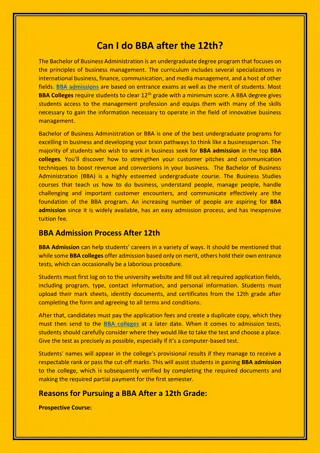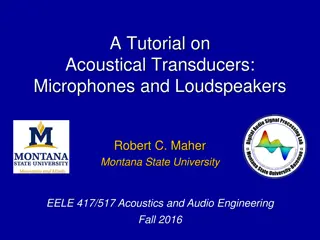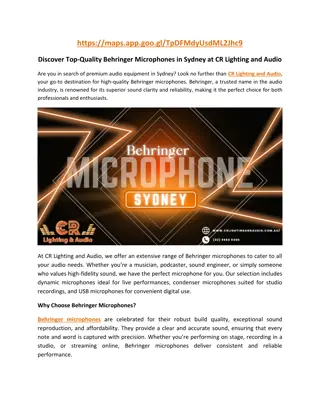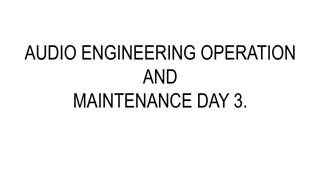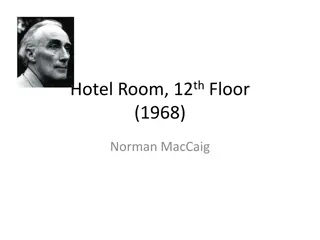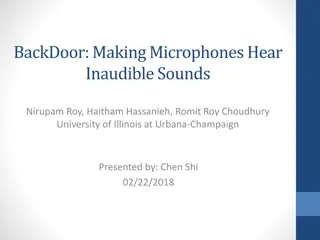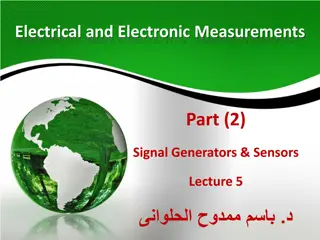
Effective Tips for Operating Boom Microphones in Studio Productions
Learn how to effectively operate boom microphones in multi-camera studio productions for high-quality sound. Discover techniques for positioning the microphone, avoiding shadows, and maintaining audio balance.
Download Presentation

Please find below an Image/Link to download the presentation.
The content on the website is provided AS IS for your information and personal use only. It may not be sold, licensed, or shared on other websites without obtaining consent from the author. If you encounter any issues during the download, it is possible that the publisher has removed the file from their server.
You are allowed to download the files provided on this website for personal or commercial use, subject to the condition that they are used lawfully. All files are the property of their respective owners.
The content on the website is provided AS IS for your information and personal use only. It may not be sold, licensed, or shared on other websites without obtaining consent from the author.
E N D
Presentation Transcript
THE BIG PERAMBULATOR BOOM
In a multi camera studio production of e.g. Soaps or comedies, you will find despite the presence of lavalier mics the big perambulator boom is still alive and well. In a controlled environment of the studio, the big boom is still one of the most effective ways of getting a high quality mic close to the talent while keeping out of camera view. There are reasons why it is not popular though: 1) It takes up a large amount of space 2) It makes lighting difficult 3) It is not easy to operate However nothing better than the boom has been made yet for picking up actors dialogue during long takes. You can extend or retract the boom, simultaneously pan it horizontally, move it up and down vertically, and rotate and tilt the mic toward the sound source. During all these operations, the boom assembly can be moved when the fully when the fully extended boom cannot reach the sound source.
HOW TO USE BOOM MICROPHONES However and whenever you move the boom, do it smoothly. Its better to be a little off while following the actors than to lose them entirely because you can t your wild boom swing in time.
OPERATIONAL TIPS Try to keep the mic in front of the sound source and as low as possible without getting it in the picture. Do not ride the mic directly above the talents head- the actor speaks from the mouth, not the top of the head. Watch the studio program monitor on your dolly(which shows the picture that goes on the air or is video recorded). Try to ascertain during the rehearsal how far you can dip the mic toward the sound source without getting it or the boom in the picture. The closer the mic, the better the sound. In the boom mic operation you will rarely get close enough to violate the minimum distance required of shotgun mics to avoid the proximity effect(breath pops and boomy bass). The optimum distance for boom mics is when the talent can almost touch the mic by reaching up at about a 45-degree angle. If the boom gets in the picture, it is better to pull it back than to raise it. By retracting the boom, you pull the mic out of the camera s view and at the same time keep it in front of, rather than above, the sound source.
Watch for shadows. Even the best lighting director cannot avoid shadows but can only redirect them. If the major boom positions are known before the show, work with the LD to light around them. You may sometimes have to sacrifice audio quality to avoid boom shadows. If you discover a boom shadow when the camera is already rolling do not suddenly move the mic- everyone will see the shadow travel across the screen. Try and sneak it out of the picture very slowly or, better, just keep the mic and the shadow as steady as possible until a change of shot allows you to move to a better position. Look for good audio balance. With a highly directional shotgun mic, you normally must rotate it toward whoever is talking. In a scripted show the audio board operator in the booth may follow the scripted dialogue and signal you(the boom operator) whenever the mic needs to be rotated from one actor to the other.
HEADSET MICROPHONES It consists of a small but good quality omni- or unidirectional mic attached to earphones. One of the earphones carries the program sound (whatever sounds the headset mic picks up or is fed from the station), and the other carries the I.F.B.(interruptible foldback or feedback) cues and instructions of the director or producer. Headset mics are used in certain EFP situations , such as sports reporting, or in ENG from a helicopter or convention floor. The headset mic isolates you sufficiently from the outside world so that you can concentrate on your specific reporting job in the midst of much noise and commotion while at the same time keeping your hands free to track players statistics on a laptop or to buttonhole or mic someone for an interview.
WIRELESS MICROPHONES In production situations in which complete and unrestricted mobility of the sound source is required, wireless microphones are used. E.g. You are recording a singer who is also doing some dance moves. Wireless mics actually broadcast their signals. They are therefore also called RF (radio frequency) mics or radio mics. Most wireless mics are used as either hand or lavalier mics. In wireless hand mics, the battery powered transmitter is built into the microphone itself. Some models have a short antenna protruding from the bottom of the mic, but in most the antenna is incorporated into the microphone housing or cable. The wireless lavalier mic is connected to a battery powered transmitter that is either worn in the hip pocket or taped to the body. The antenna is usually tucked into the pocket or strung inside the clothing.
An important element of the wireless microphone system is the receiver. The receiver tunes in to the frequency of the wireless transmitter and can receive the signal from as far as 1,000 feet (approximately 330 meters) under favourable conditions. When conditions are more adverse, the range may shrink to about 100 feet(about 33 meters). To ensure optimal signal reception, you can set up several receiving stations in the studio as well as in the field. When the signal gets too weak for one of the receivers, the other or others will take over. This is called diversity reception. The wireless mics work best in the controlled studio environment where you can determine the precise range of the performer s movents and find the optimal position for the receiver(s). Most singers prefer the wireless mic because it offers unrestricted movements. It is also good for audience participation shows where the performer or host walks into the audience for brief unscripted interviews.
WHEN USING WIRELESS MICS: WATCH OUT FOR THESE PROBLEMS: WATCH OUT FOR THESE PROBLEMS: If the transmitter is taped to the body, the performer s perspiration can reduce signal strength. Large metal objects, high voltage lines and transformers, X-ray machines, microwave transmissions, and cellular phones- all can interfere with the proper reception of the wireless mic signal. Although most wireless equipment offers several frequency channels, there is still some danger of picking up some extraneous signals, especially if the receiver operates in the proximity of someone else s wireless signals or other strong radio signals. Interference is evident by pops, thumps, signal drop outs, and even the pick up of police band transmissions. If you use several wireless mics, they need to be fed into a mixer for proper audio control.
DESK MICROPHONES These are stationary mics usually put on tables or desks. They are widely used in panel shows, public hearings, press conferences, and other programs where the performer is speaking from behind a desk, table, or lectern. These mics are used for voice pick up only. Because the performer is usually doing something- shuffling papers, putting things on the desk, accidentally bumping the desk with feet or knees- desk microphones must be rugged and able to withstand physical shock. Dynamic, omnidirectional mics are generally used as desk mics. If a high separation of sound sources is desired, however, unidirectional mics are an option. When you use a desk mic for a speaker at a lectern, use a unidirectional rather than an omnidirectional mic. The unidirectional mic will make it easier for you to avoid feedback through the speakers in the same room. When properly placed the unidirectional mic is less apt to cause feedback. Most hand mics double as desk mics- you just place them on the desk and position them for optimal sound pick up.
HOW TO USE DESK MICS o Desk mics are irresistible and performers when sitting or standing behind a desk mic always feel compelled to touch it and move it closer to them. To avoid this, try taping the mic stand to the table or at least tape the microphone cable securely and unobtrusively so that the mic can be moved only a short distance. o No attempt is made to conceal this mic from the viewer however consider the camera picture as well as optimal sound pick up. Performers certainly appreciate it when the camera picks more of them than the microphone. o If the camera shoots from straight on, place the mic somewhat to the side of the performer and point it at his or her collarbone rather than the mouth, giving a reasonably good sound pick up while allowing the camera a clear shot of the performer s face. o Always remember to conceal the mic cable as best as you can. It should never be in the shot.
oWhen using two desk mics for the same speaker as a dual redundancy precaution, use identical mics and place them as close together as possible. Dual redundancy is the rather clumsy term for using two mics for a single sound source so that you can switch from one to the other in case one fails. oDo not activate them at the same time unless you are feeding separate audio channels. If both mics are on at the same, you may experience multiple-microphone interference, which means that when the mics receive the same sound at slightly different times, they tend to cancel each other s frequencies. To avoid such interference, place the mics so that they are at least three times far apart as any mic is from its user. oAlways advice the performer or anyone using the desk mic not to reposition it once it is set to avoid banging on the table or kicking the lectern, even if the discussion gets lively. Tell the performer or participants not to lean into the mic when speaking.
STAND MICROPHONES These are used when the sound source is fixed and the type of programming permits them to be seen. E.g. When recording a rock concert; they are an important show element. The quality of stand mics ranges from dynamic hand mics clipped to a stand to highly sensitive ribbon or condenser mics used exclusively for music recording sessions.
HOW TO USE STAND MICROPHONES They are usually placed in front of the sound source-whether it is a singer or a speaker of an amplified electric guitar. Make the mic easy to unclip from the stand, mucisians like to unclip and hold the mic as they perform. For the pick up of a singer using an acoustic guitar, you may attach two mics to a single stand: one for the singer and one a little lower for the guitar.
HANGING MICROPHONES These are used whenever any other concealed-microphone method (boom) is impractical. They are high quality unidirectional mics that are normally suspended by their cables from the lighting grid. You can hang the mics (high quality cardioid condenser mics but also lavaliers) by their cables over any fairly stationary sound source. Most often, hanging mics are used in dramatic presentations where the action is fully blocked so that the actors are in a precise location for each delivery of lines. A favourite spot for hanging mics is the upstage door (at the back of the set), from which the actors deliver their hellos and goodbyes when entering or leaving the major performance area. The actors have to take care to speak only within the audio pool of the hanging mic. The audio pool allows actors to be heard only when they are within the limited range of the mic. The sound quality from hanging mics is not always the best. The sound source is often at a distance from the mic, and if the actor is not precisely within the audio pool, his or her voice is off-mic.
In the case of the upstage door, such quality loss is actually an asset because it underscores the physical and psychological distance of the departing person. DISADVANTAGES DISADVANTAGES Hanging mics tend to pick up the shuffling of feet and the rumbling of moving camera pedestals almost as well as voices. When positioned close to the studio lights, the hanging mic might pick up and amplify their hum. NOTE NOTE When suspending a microphone from the lighting grid, be careful not to place the mic next to a hot lighting instrument. It will inevitably pick up its hum. Separate the mic cables from the studio lights or the AC cables to minimize electronic interference. If this is not possible cross the mic and power cables at right angles rather than having them run parallel.
HIDDEN MICROPHONES You may be in a situation where you have to hide a small lavalier mic in a bouquet of flowers, behind a centre piece, or in a car to pick up a conversation during a studio production or EFP where microphones should be out of camera range. It is time consuming to hide a mic where the camera will not pick it and still get satisfactory sound pick up. You may end up getting all other noises, e.g. The banging of a table, moving of chairs but only a poor pick up of the conversation.
HOW TO USE HIDDEN MICROPHONES Hiding microphones presents unexpected problems. Here are tips to minimize them. Do not try to conceal the mic completely unless there is an extreme close up of the object to which it is attached. You must hide the cable attached to the mic as well. If you are using a wireless mic you must also hid the transmitter as well. Secure the mic and cable with tape so that they do not come loose. Do not hide a mic in enclosed spaces such as drawers or boxes. The highly reflecting enclosure will act as a reverberation chamber and make the voices sound as though the actors themselves were trapped in the drawer.
LONG DISTANCE MICROPHONES It is often the sounds more than the pictures that carry and communicate the energy of an event. The simplest way to pick up the sounds of a sporting event is to place normal shotgun mics at strategic positions and aim them at the main action. The sounds of the spectators are picked up by additional omnidirectional mics. Coverage of a single tennis match may involve 6 or more microphones to pick up the sounds of the players, the judges, the ball, and the crowd. Always place a fairly dense windscreen on every mic to eliminate wind noise as much as possible.
SUMMARY 1) Audio is the sound portion of a television show. It transmits information (such as a news story), helps establish the specific time and locale of the action, contributes to the mood, and provides continuity for the picture portions. 2) The three major types of microphones are dynamic, condenser, and ribbon. Each type has a sound generating element that converts sound waves into electric energy the audio signal. 3) Some microphones can hear sounds equally well from all directions( omnidirectional); others hear better from a specific direction (unidirectional or cardioid).
Microphones are classified according to their operation and are either mobile or stationary. The mobile types include lavalier, hand, boom, headset, and wireless mics. The stationary types include desk, stand, hanging, hidden, and long distance mics. The lavalier microphone is most common in normal television productions. It is usually clipped to clothing. Although it is extremely small it provides high quality sound reproduction. Hand microphones are used when the performer needs to exercise some control over the sound pick up. When the microphone must be kept out of camera range, it is usually hand held or mounted on and operated from a microphone boom. All boom mics are highly directional. The headset mic is used when the talent needs both hands free to take notes or work with scripts or a keyboard. Headset microphones are especially practical for sportscasting and ENG from a helicopter or convention floor. When unrestricted mobility of the sound source is required, a wireless, or RF(radio frequency), microphone is used. Also called radio mics , wireless mics need a transmitter and a receiver. Desk mics are usually hand mics clipped to a desk stand. They are often used for panel discussions.
Stand microphones are employed whenever the sound source is fixed and the type of programming permits the mics to be seen by the camera, such as in a concert. Hanging microphones are popular in some studio productions because the mics are kept out of camera range without using booms. Hidden microphones are small lavaliers concealed behind or within set dressings. Shotgun microphones are long distance mics that pick up sound over relatively great distances.




